Melt (2023)



Melt (2023)
Philip Zimmermann
Smyth-sewn book with exposed spine, and enclosed in a small tin box with a clear window on the front. Box: H140 x W93 x D24 mm; Book: H130 x W93 x D16 mm. 200 pages. Edition of 175, of which this is #82. Acquired from Spaceheater Editions, 4 February 2024.
Photos: Books On Books Collection.
Melt is the second work in a climate change trilogy, the first being Landscapes of the Late Anthropocene (2017/19), which appears below. More complex in its material, Melt may self-ironically have a larger carbon footprint than its predecessor more from its process than the material involved. As the artist describes it,
… it is also a conversation with two generative artificial intelligence entities. ChatGPT and DALL-E, both from Open AI: one generates the text, the other the pictures. What results is an unsettling combination of wisdom from an artificial human creation talking into the void as the ice melts and sea-levels rise.
And Melt is high-tech in other ways as well. It is
printed by one of the latest updated printing technologies, high-speed UV-cured inkjet. It was printed on a Komori Impremia IS29s digital press at Spectrum Printing in Tucson, Arizona. It is a new and improved version of that digital inkjet sheet-fed printing method that is not only very fast, but also light-fast, and uses stochastic imaging, which means there are no halftone dots. The finished prints rival or exceed the quality of high-quality offset lithography.
If the printing industry has in fact been reducing its CO2 emissions and since digital press printing is self-evidently more environmentally friendly than earlier processes (Kariniemi, 2010), Melt has a reduced carbon footprint on that score. The carbon footprints of ChatGPT and DALL-E, however, are not nil (Heikkilä, 2022).

So their use in Melt must increase its footprint, as must the use of traditional bookmaking technology and material: smyth sewing, glue, paper, foil, etc. There’s even the non-traditional material of the tin box and its clear plastic window. As becomes evident by the end of the book, all this is a complex irony not lost on the artist. Indeed the irony becomes self-referential in the book art tradition of self-referentiality.
Melt is a grimly playful book.
Its DALL-E dialogue of prompt and response focuses attention on the polar images generated on the lefthand page. While that’s going on, and in response to an AI prompt to list the first 100 coastal cities that will be submerged by rising tides, a scale on the lefthand edge shows the rise in sea-level and provides the answer to the prompt by pairing the sea level with the city falling beneath it — the first two being Miami and Osaka. By the end of the book, the last two cities to be submerged are Kyoto and Beijing.


While these verso page images are appearing, another set of images vies for attention on the recto pages — scans of old land maps and a superimposed time-lapse photo of a glass of melting ice. The maps show traditionally hot areas in Arizona and New Mexico, and as the book progresses, the maps redden while the ice melts, which can be appreciated by riffling the pages like a flipbook (see video of this here).


For the slower page-by-page reading, there are the instructions addressed to ChatGPT and its various textual responses to them. The human book artist is having his grim fun with this AI and with us. Part way through, over DALL-E’s images of calving glaciers, he superimposes lyrics of the 19th century song “A Life on the Ocean Wave” with obvious (for us humans, at least) irony.

Shenzhen “is no longer in view”.
But then, just to rub it in, he prompts ChatGPT to “Write a few paragraphs on how the poem (and later song lyrics) “A Life on the Ocean Wave”, by Epes Sargent, relates to sea-level rise, metaphorically, ironically, or otherwise”. ChatGPT’s eerily human-sounding response is a joke on us climate-changing humans, perhaps matched only by the artist’s prompting DALL-E to “generate a picture of a flooded computer facility with rack after rack of ruined mainframes, used by one of the largest corporations that process artificial intelligence requests”. Below is Dall-E’s final image. One wonders what ChatGPT might write if prompted “Write a few paragraphs on what you as an AI think of the image below”.

By playing DALL-E and its images off ChatGPT and its text, Melt notches up an innovation in the tradition of image-text interplay in artist’s books. We’ve already seen the subtle calling attention to this with the flipbook mechanics vs the slow read of AI text. There’s also ChatGPT’s speculation on the relevance of Robert Frost’s poem “Fire/Ice” to climate change, which the artist juxtaposes with DALL-E’s verso polar images that face the reddening recto pages. Even more directly Zimmermann calls attention to the interplay by asking ChatGPT to come up with a list of images to illustrate climate change and generate a sense of urgency, which DALL-E seems to ignore as it carries on with its own verso-page dialogue of prompts and polar images.
As suggested at the start of this entry, perhaps the most subtle reference to book art’s traditions comes at the end of the book. Melt‘s final image can be read not only as an ironic joke on the AIs but as a joke on us and a self-referential claim by Melt. The jokes, of course, are that the AI pontificating about climate change has an impact on its own environment, and that all of the impacts are our impacts. As for Melt‘s self-referential claim, consider the Dutch artist Thijs Biersteker’s words:
… artwork and installations that uncover and visualize the environmental impact of AI and tools like ChatGPT are essential in today’s rapidly evolving world. By raising awareness, humanizing the technology, encouraging responsible behavior, providing a platform for dialogue, fostering emotional connections, and promoting environmental stewardship, art can play a pivotal role in addressing the environmental challenges posed by AI. Through creative expression, we can inspire meaningful change and ensure a sustainable future for both AI and the environment. — Woven Studio [before 7 May 2023].
Melt is one such creative expression.
Landscapes of the Late Anthropocene (2017)

Landscapes of the Late Anthropocene (2017)
Philip Zimmermann
Offset. Two-staple binding. 44 pages. H134 x W107 mm
Acquired from Journal of Artists’ Books #41, 25 July 2017. Photos: Books On Books.



It opens with sunrise, closes with sunset. Each landscape shows water meeting land. Airport control towers appears in each landscape. Some stand on promontories, some are nearly submerged. Tinted pages of NOAA charts of the Bahamas, Florida Keys and Gulf of Mexico lay between the pages of landscapes. The sentences placed across the charts in silvery white come from the random-seeming, poetic-sounding “Harvard Sentences“, used by audio engineers and speech scientists in Harvard’s Psycho-Acoustic Laboratory from the mid-20th century to the present to test the effects of noise on comprehension.
There are 72 ten-sentence banks in the Harvard Sentences. The artist’s choice of three sentences for each chart page is like a painter’s choice of colors and strokes.
“Men think and plan and sometimes act” is the first chosen. “A pink shell was found on the sandy beach” is the last. In between come “reds” like “Let it burn, it gives us warmth and comfort”, “greens” like “Lush ferns grow on the lofty rocks” or “blacks” like “That move means the game is over”. The sentences seem to change their color or meaning as the eye moves among the landscapes. What color has “Canned pears lack full flavor”?
The only other man-made structure in the book appears halfway through: the roof of a log cabin with the water almost to the eaves.
A small work of book art with an overwhelming force.

Under his Spaceheater Editions imprint, Zimmermann also produced a limited hardback edition, which includes an eight-page sewn pamphlet describing the work.

Landscapes of the Late Anthropocene (2019)
Philip Zimmermann
Offset lithography, 4/c and duotone plus metallic silver. Paper: Mohawk Superfine. 142 x115 x 12 mm. Acquired from the artist, 23 February 2020. Photos: Books On Books.


Incident in Deseret (2014)


Incident in Deseret (2014)
Philip Zimmermann
Hard-covered board book with drum-leaf binding, enclosed in archival box with title pasted on front cover and spine. Box: H212 x W215 x D25 mm; Book: 203 x 203 x D20 mm. 30 pages. Edition of 30, of which this is #17. Acquired from Spaceheater Editions, 4 February 2024.
Photos: Books On Books Collection.
Incident in Deseret wastes no time and little space on preliminaries. The board book pulls you in straightaway — just the way a children’s board book might — with impressive edge-to-edge photos of the setting. Where you would expect to find the text of a copyright page, title page, etc., the only words you see are as much the opening to a mystery as an identification of the locale. After all, “deseret” might be a typo for “desert” unless you know that it is the name the Mormons called the provisional state from which Utah emerged. If you do, you will likely identify the wasteland as Utah’s Great Salt Lake. But given that only the edges of the book’s drumleaf binding provide the confirming details (more on this later), you can safely conclude that this preliminaries-less opening reflects a clear intention: to reserve the book’s pages for telling a story.

The story’s first action adds to its fictitious fiction. It is no accident that Robert Smithson’s The Spiral Jetty is not named within the book but only on the edges of the covers. The iconic artwork in a remote desert is being appropriated, tongue in cheek, as a supernatural phenomenon “unrestrained by man” despite being very much a human work of art imposed on the natural.



The arrival of “Elders”, all in black, heightens the religious overtones, but as with Smithson’s artwork, the religious term is being appropriated: the Elders’ activity seems more that of scientists and surveyors, which later in the book they confirm by arguing “over the cosmic reasons for the spiral”, checking and rechecking their observations, making final calculations.

On the other hand, what kind of scientists and surveyors use “celestial nauvoocorders”? Like the setting, Nauvoo is borrowed from the Mormons, a name that their founder Joseph Smith gave to Commerce, Illinois upon settling there in 1840 for six years. Although Smith wrote that the name derived from the Hebrew word meaning “beautiful”, the word “nauvoocorder” is the artist’s portmanteau for the Elders’ cameras recording the phenomenon of “celestial beauty”, and so is “nauvooite” for the chunks of salt they collect. Other borrowings from the Mormons are “Kolobian” (relating to Kolob, the heavenly body nearest to the throne of God) and “telestial” (“Of or pertaining to the lowest degree of glory“), but in the context of the story, the words could come from a tale of science fiction.

And eventually the final main activity is one of science fiction, and like much of science fiction, the conclusion to the story closes full circle.


A further word about the binding that has facilitated this uninterrupted tale.
With the unusual drumleaf binding, the artist gives himself the space for the absent preliminaries. It expands the edges of the frong and back covers. Here is where the copyright page, title page and dedication appear. Printed around the front drumleaf cover’s four edges is the following:
Incident in Deseret | Philip Zimmermann | Spaceheater Editions | 𐐸𐐬𐑊𐑉𐑌𐑅 𐐻𐐭 𐑄 𐑊𐐫𐑉𐐼
𐐸𐐬𐑊𐑉𐑌𐑅 𐐻𐐭 𐑄 𐑊𐐫𐑉𐐼 | Published by Spaceheater Editions | 5467 East Placita del Mesquite, Tucson
Arizona 85712 | http://www.spaceheatereditions.com | 520.979.8407 | This book is dedicated to Karen on
whose fifty-second birthday we visited The Spiral Jetty in the Great Salt Lake | 𐐸𐐬𐑊𐑉𐑌𐑅 𐐻𐐭 𐑄 𐑊𐐫𐑉𐐼
And around the back drumleaf cover’s four edges:
Incident in Deseret is published in two different editions, both are 2014 by Philip Zimmermann
𐐸𐐬𐑊𐑉𐑌𐑅 𐐻𐐭 𐑄 𐑊𐐫𐑉𐐼 | This book is one of a series of seven books inspired by a group visit on
2014.01.05 to Robert Smithson’s Spiral Jetty, each book by a different artist.| 𐐸𐐬𐑊𐑉𐑌𐑅 𐐻𐐭 𐑄 𐑊𐐫𐑉𐐼
𐐸𐐬𐑊𐑉𐑌𐑅 𐐻𐐭 𐑄 𐑊𐐫𐑉𐐼 | One in a series of seven books on the theme of The Spiral Jetty


The Deseret characters along the covers’ edges come from a public domain TrueType font called Huneybee Regular, which seems to be no longer available. The font here comes from the Deseret Alphabet Translator, which first appears on 17 September 2014 in the Internet Archive. The last three words in Deseret — 𐐻𐐭 𐑄 𐑊𐐫𐑉𐐼 — are “to the Lord”, but the first — 𐐸𐐬𐑊𐑉𐑌𐑅 — does not work as the intended transliteration of “Praise”. It should be 𐐑𐐡𐐁𐐞 in all caps or 𐐑𐑉𐐩𐑆 in cap and lowercase. In all caps, the entire phrase would be 𐐑𐐡𐐁𐐞 𐐓𐐅 𐐜 𐐢𐐃𐐡𐐔, but in the story’s context, accuracy in a particular religious script is not the point. More to the point is the way the script happens to echo the shape of Smithson’s Spiral Jetty, which Zimmermann has hijacked for the mysterious appearance and disappearance for the Elders’ investigation and interpretation. In that echo, the edges are drawn into the story.

Faith fascinates Zimmermann as an artist rather than a believer. Like many book artists, he finds in religion a source of commentary on human interaction with the environment (as above) and on humans’ interaction with one another (so below).
Sanctus Sonorensis (2009)

Sanctus Sonorensis (2009)
Philip Zimmermann
Perfect bound, self-covering board book, illustrated cover, gilt on top, bottom and fore edges. Gold-foiled title on the cover and spine. Four-color offset lithography. H273 x W208 x D35 mm. 90 pages. Edition of 1000. Acquired from Spaceheater Editions, 4 February 2024.
Photos: Books On Books Collection.
Sanctus Sonorensis begins and ends with double-page ground-level view of a patch Sonoran desert. In between, a series of spectacular double-page skyscapes takes the reader from dawn to moonrise over the desert. A litany of blessings — from “blessed are the wetbacks” to “blessed are the grave diggers” — occupies thirty-three of the double-page spreads. The roles are not exactly at odds with the Beatitudes of the New Testament, but they are insistently more numerous and particular. By the time evening is coming on in this location, the reader is safe to assume that these blessings are on illegal migrants. But who is extending the blessings? The deity, the artist, the migrants, non-migrants?


It’s complicated. There are mixed “material” signals on the journey as well. The rounded corners and gilt edges are reminiscent of religious breviaries or missals suit the text, but the board book construction is more common to children’s books, and yet the boards’ gilt edges urge more careful and slow page turning than do children’s books.

Also in contrast with the gilt rounded corners of a breviary or missal are the full-bleed double-page photos recalling a photobook or magazine. Yet the constant skywards view reinforces a prayerful, not playful or casual, perspective. That view would most likely belong to migrant eyes. Perhaps the blessings are self-blessings. For the non-migrant reader, the particularity of the roles and prayerful perspective might at least prompt an empathetic (or at least sympathetic) attitude, and perhaps that reader joins in the blessings.
As the blessings come to an end, there is a text-less double-page spread of a sunset sky. Then as the sunset deepens in the next spread, more text appears, akin to another New Testament prayer:

As this list continues — “let us forgive the Border Patrol, let us forgive the Minutemen, let us forgive la migra” — it seems to come more from the migrant perspective. Los coyotes (above) refer to the people smugglers on the southern US border. La migra is short for inmigracíon or immigration and can be short for migrant, but it is also migrants’ slang for any immigration officials. If a non-migrant reader is uttering this invocation, it would have to be one who has signed on in all humility to the irony of William Tyndale’s version of the Lord’s Prayer in Luke 11:
And forgive us our trespasses,
as we forgive those
who trespass against us.
Long Story Short (1999)
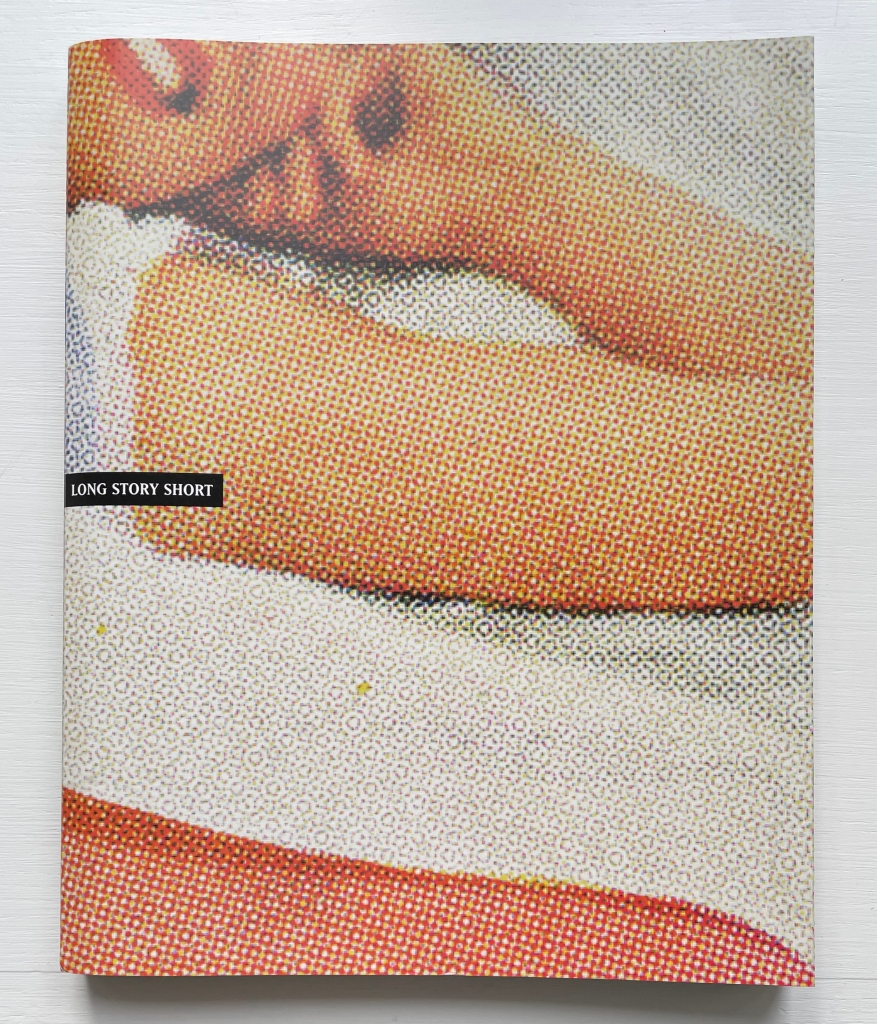
Long Story Short: Home is Where the Heart Is (1997-99)
Philip Zimmermann
Wire-o-binding with wrap-around softcover, optical plastic title page H267 x W212 x D15 mm. 145 pages, including cover and wrap-around cover. Edition of 750. Acquired from the artist, 4 February 2024.
Photos of the work: Books On Books Collection.
A cross between shaggy dog story, magician’s show and artist’s book, Long Story Short is anything but short. Opening the book delivers several tricks at once. First, there’s the “reveal” of the wire-o-binding hidden by the wraparound cover. At the same time, there’s the strange half-title page that seems embedded in some sort of thick piece of plastic, but this is an optical illusion that becomes apparent as you lift the thin sheet of plastic from over the half-title page underneath. But before you turn the eye-tricking plastic sheet fully to the left, you notice the cover’s folded flap.


If you fold that flap out, the three-page spread probably leaves you puzzled. Other than the recurrent enlarged halftone dots and the images of hands, there’s not much in common across the spread to offer a clue to what’s going on. It’s enough to make you turn the whole thing over to see if the other side offers a clue.


Hmm, while the outside of the wraparound cover shows a double-page spread with a joined-up image, the flap page, now on your right, does not seem to relate to it — other than with the enlarged halftone dots and the hands. Oh well, back to the beginning to turn that plastic sheet. Resting on a single sheet, the uncovered half-title page salutes the number 40 while its verso partner takes on a 3D appearance. Still a puzzle, but the next double-page spread with its magician’s show of an empty pair of hands crossed (or a mirror image of a single hand open) confirms the handsy theme and trickery afoot — or rather at hand. So turn the recto page (again, a single sheet), and the verbal-visual punning starts — from scratch, of course.
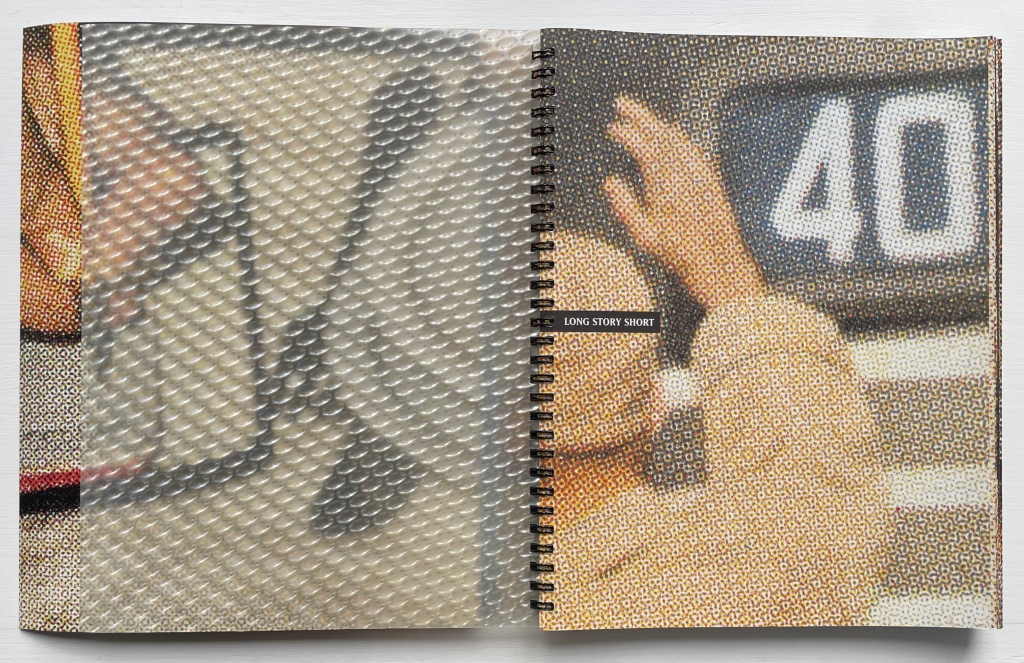
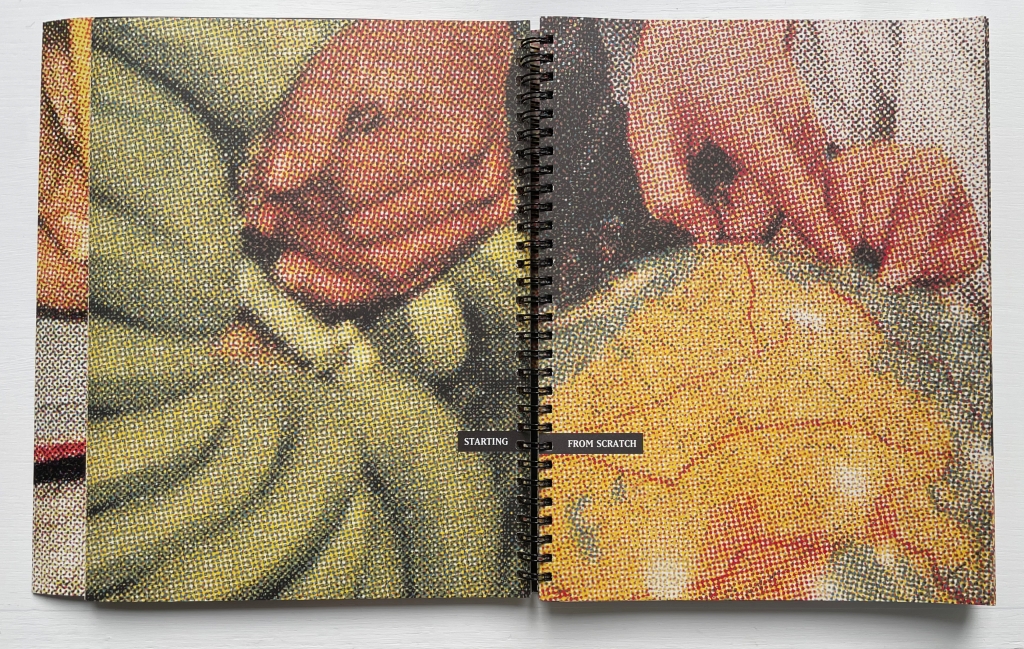
Will this be a children’s picture book about where green bananas come from? But wait, your fingertips are telling you that the recto page is on a folded sheet. Turn it, and the word game and the double-spread of two folded sheets on which it appears tell you that you are just scratching the surface. So open up the two folded sheets to find out what’s below the prim and proper.
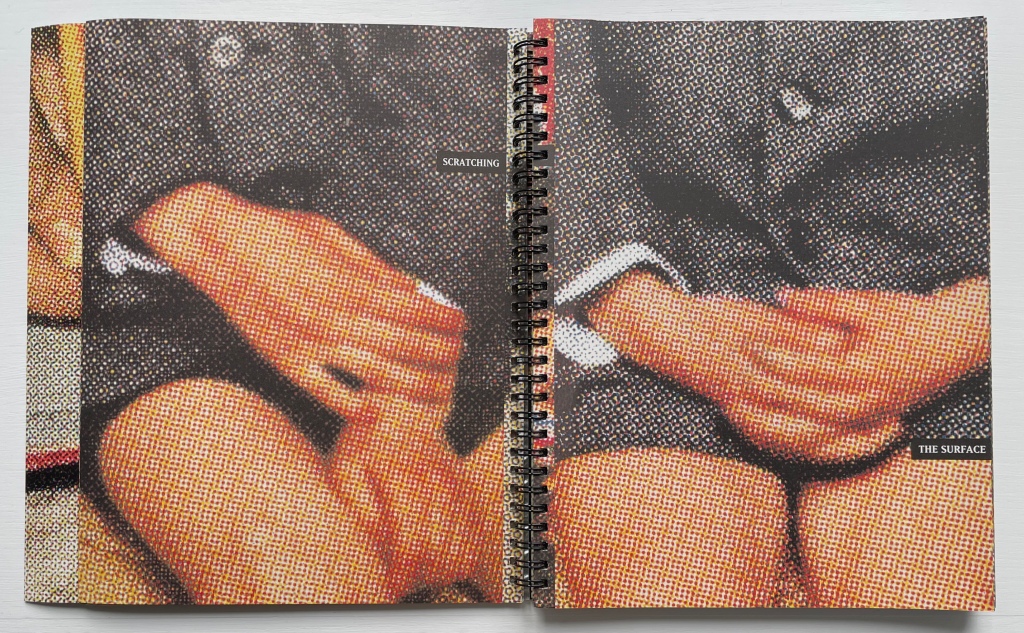
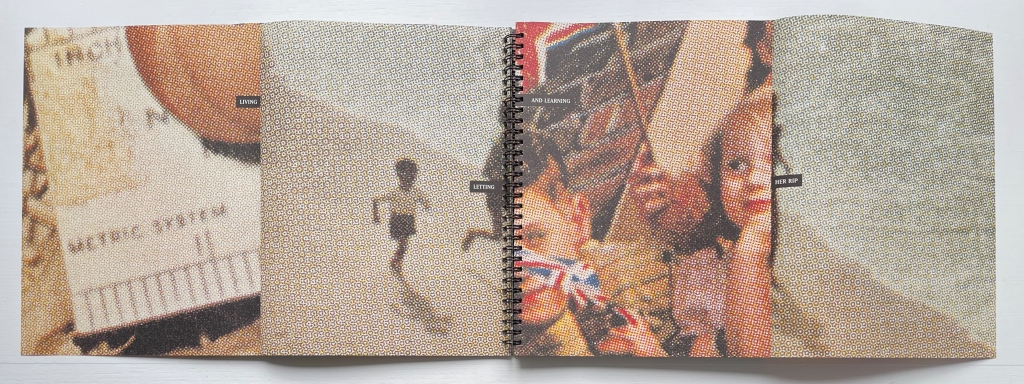
So now you know that this artist’s book is about “living and learning” and jumping over one page to another to do it. It’s about different measures (metrics) of the same thing and the borders they signal along which we have to run, “letting her rip” as in splitting a photo in two and leaping across an ocean to another country. It seems you are being whisked back in time to childhood, and if you refold the sheets and turn the page, there’s your 1950s dad looking over your shoulder, pointing something out in that long-ago country or sending you to the corner. It’s all about “learning the ropes” as the next double-spread of two folded sheets suggests.


Like the splitting of phrases across pages, the book’s mix of single sheets and folded sheets slows down its reading. You have to take care to pick them apart. Another technique that makes this long story anything but short is a kind of harlequinade of aphorisms. From folded to unfolded, a spread can turn one saying into another, or on a single page, you may have to read diagonally from right to left, or you may find a phrase wrapping around the edge of the page and becoming yet another phrase and another as the sheets fold and unfold.
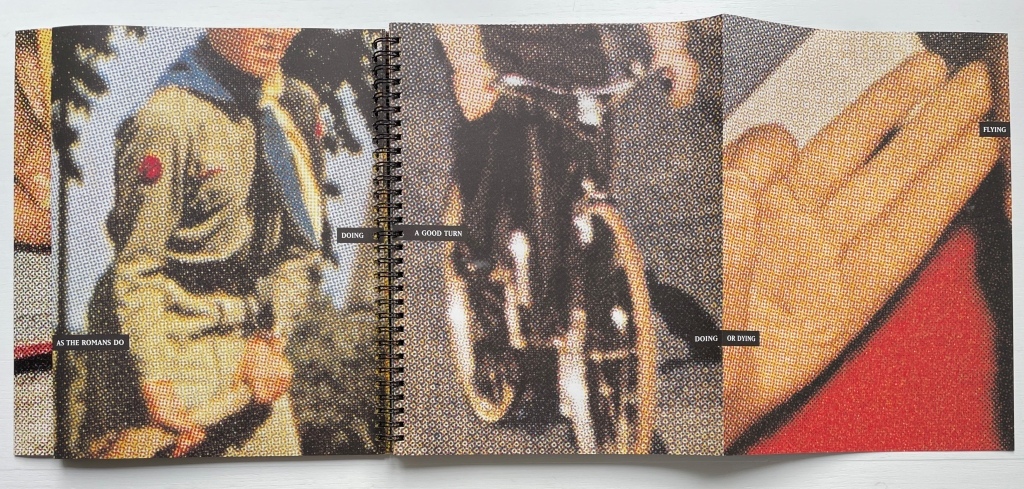


If you are not a Boomer, you can turn to the artist’s description to learn that all of the images come from sections of Look, Life, and other magazines from the fifties. Artists and close readers will appreciate his expansion on the technique of using large halftone dots:
I wanted all of the blown up halftone dots to be the same size, so I used a screen angle indicator to determine the line ruling of the originals and then used a calculator to determine the blown up size of the dots of the final image. I had a small rectangular mask that I would then place over the printed photo images to determine the crop. Then I scanned them in at very high resolution so that they could be blown up.
Despite its blurring or dissolving effect, the technique delivers a kind of visual unity or binding across the many crops and jumps from one image to another and across the single sheets and folded sheets. It combines with the recurrence of hand images to hold the work together. This tension between unity and fragmentation also plays out across the aphorisms breaking up and then reforming. And if in all that tension you cannot determine exactly what the long story short is, well then, “live and learn”.
High Tension (1993)

High Tension (1993)
Philip Zimmermann
5.5 x 7.9″; 96 pages. Pentagon with 4″ spine and each of the other sides 4.25″. Unmatched irregularly cut pages. Offset printed. Produced and printed for for Montage ’93, International Festival of the Image, Rochester, NY, 1993.
High Tension is a porcupine of a book. As Johanna Drucker put it, “It’s about anxiety, and it pricks your fingers as you turn the pages.”



The work has been well-described in The Cutting Edge of Reading:
[High Tension] overwhelms us with a surprisingly varied profusion of images. Each of the many double pages introduces at least one radically new picture having more often than not merely a marginal relationship with those that had preceded. We must process these words somewhat gingerly in terms of our own past experiences when immediate recognition fails. It would therefore appear that unpredictability characterizes the selection and succession of the graphics. Each new image has its own motif and its own color scheme. Dealing in its own way with representation, it imposes its own focus and its own scale to which the reader must adapt. Thus, each turning of a page practically guarantees a further disruption and reduces any hope that we may have entertained of discovering either a formal or a thematic continuity. Instead, it calls forth unsuspected resources within us. Surprise follows surprise without affording a moment of relaxation. Each page relentlessly renews the shock of novelty, but in so titillating a manner that we must dwell on each image without any desire to skip. The artist has of course abandoned or deliberately misapplied expected formats. The pages may overlap, but they never coincide with one another. Deviation happens on two levels: each page slants diagonally and, when turned, symmetrically prolongs across the gutter the preceding one. Thus, two successive pages point in opposite directions while jointly providing a partially coherent and integrated image — partially, because fragments of images from other double pages show a propensity to migrate or, if we may use a medical term in describing a pictorial and psychological venture, metastasize. As we move along, we can hardly avoid twisting and turning the book around for successive viewings of the double paged pictures. Obviously, we can no longer rely on the measured progress so characteristic of reading. Moreover, the angularity of the pages greatly increases the nervous energy of their graphic and verbal content. …
Renée Riese Hubert and Judd D. Hubert, The Cutting Edge of Reading: Artists’ Books (New York: Granary Books, 1999), pp. 168-73.
There are also third and fourth deviations to add to what the Huberts observed above. Note how the orientation of the text and images varies across the double-page spreads. Text runs at different diagonals and sometimes apparently horizontally as expected (for example, in all of the spreads below). Sometimes images are vertically aligned within the double-page spread but at an angle (for example, the graph below), and sometimes horizontally (for example, the Masaccio below that).




Zimmermann himself writes at length and self-critically about the work on his website:
This was the first book that I had ever done that was completely imaged and output on a computer. I used my Macintosh to lay out the pages and then output the film at Purchase College on the AGFA image setter we had there. I did all the film assembly and made the offset plates at my studio at home in Barrytown NY and then took the finished plates up to Rochester in April of 1993 for printing. Pressman Paul Muhle did the presswork this time, on the same Heidelberg KORD press. …
I was at VSW for two weeks during the printing of High Tension, living in the artists’ apartment there at 31 Prince Street. The book was then packed up and sent out to Publisher’s Bookbindery in Long Island City for the die-cutting and foil stamping and finally the smythe-sewing. As it turned out, the book was sub-contracted to a bindery in western Massachusetts. Every aspect of the job was botched and I lost about a third of the edition of a thousand to mis-registered die cutting, torn pages, badly sewn books and many other problems. High Tension was a very difficult binding job, it is true. There are no right angles to line the signatures up by. However I think that when the bindery realized how difficult a job it was they decided to just slap it out with no care whatsoever rather than lose a lot of money on it. Because of the due date being the opening of Montage ‘93 in July of 1993 I had no choice but swallw [sic] the bad binding. If I had time, I would have forced the bindery to reprint the whole book and do the job over again. I had a very precise die-cut master sent with the job that somehow got lost and I later found out that was why the die-cutting was so poor.
The budget for the book was substantial both because of the rather large amount of production money from Montage ‘93 but also because of a Faculty Development award from Purchase. I also contributed some of my own money. Still the money was not enough to do the whole book by full color CMYK process printing. So I decided to try to output everything to three-color CMY separations, which required some special fiddling with Photoshop. That meant no black ink at all is used in the whole book, which few people realize. The entire book was done as three color “process”. This saved one set of plates and one press run for each side of every printing form, but it was much harder to print for the pressman because ink levels really had to be turned way up on the coated paper to get anything close to a black made up of just cyan, magenta and yellow. In retrospect I wish I had just found the money and printed it as normal CMYK sets because the blacks are not as good as normal and are uneven.
One additional innovative production feature of the cover was that I made a duotone foil stamp, which as far as I know is the first time that had been done other than the cover I had done for an earlier book Interference published by Nexus Press.
Philip Zimmermann, “High Tension”, Spaceheater Editions. Accessed 27 February 2020.
As with Landscapes of the Late Anthropocene, reading Zimmermann about the process and technique is an education in how to look at book art.
Further Reading
“An Online Annotation of The Cutting Edge of Reading: Artists’ Books“, Books On Books, 7 September 2017.
Biersteker, Thijs. [before 7 May 2023]. “MB>CO2 the ChatGPT edition: A Dystopian Art Experience Unmasking the Hidden CO2 Emissions from AI Models Like ChatGPT“. Thijs Biersteker, Woven Studio. Accessed 13 February 2024.
Heikkilä, Melissa. 14 November 2022. “We’re getting a better idea of AI’s true carbon footprint“. MIT Technology Review. Accessed 13 February 2024.
Kariniemi, Merja; Nors, Minna; Kujanpää, Marjukka; Pajula, Tiina; and Pihkola, Hanna (VTT Technical Research Centre of Finland, Espoo). Nov/December 2010. “Evaluating Environmental Sustainability of Digital Printing“. The IS&T Reporter. 25:6. Springfield, VA: Society for Imaging Science and Technology.
Rafferty, Colin. 12 January 2006. Interview with Colin Rafferty, Book Arts Podcasts, University of Alabama. Accessed 6 February 2014.
Van Wyk, Gary. 2018. Our Anthropocene: Eco Crises. New York: Center for Book Arts. Descriptive catalogue of an exhibition (19 January – 31 March 2018), p. 18.
White, Tony. 2012. “From Democratic Multiple to Artist Publishing: The (R)evolutionary Artist’s Book“, Journal of the Art Libraries Society of North America, Vol. 31, No. 1, pp. 45-56. Accessed 17 January 2020.
Zimmermann, Philip. 20233. Youtube video of Melt.
Zimmermann, Philip. Artist’s statement on Landscapes of the Late Anthropocene. Spaceheater Editions. See also a Youtube video of the hard bound edition.
Zimmermann, Philip. 2013. Youtube video of Sanctus Sonorensis.
Zimmermann, Philip. 2014. Youtube video of Incident in Deseret.
Zimmermann, Philip. 2013. Youtube video of Long Story Short.